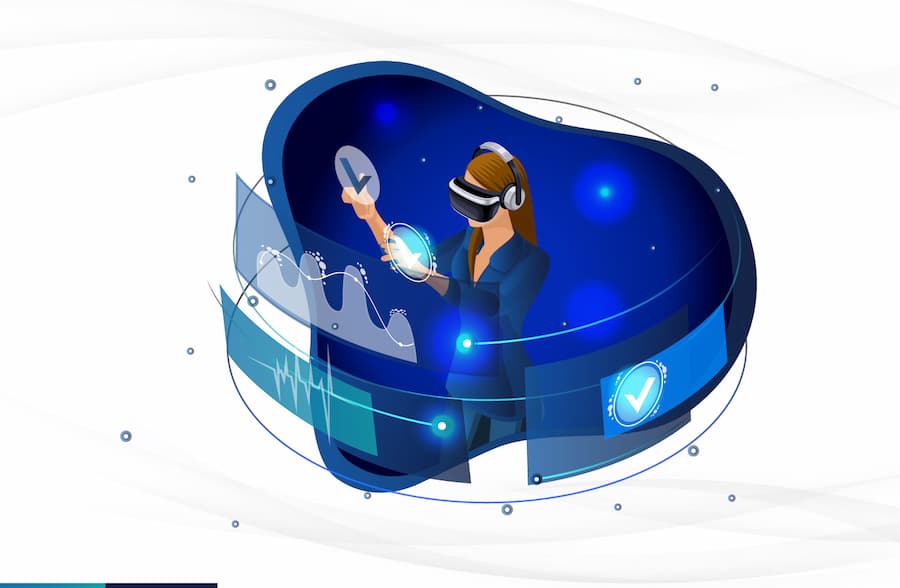Augmented reality (AR) and virtual reality (VR) are game changers for businesses. From virtual try-on clothing in retail to virtual tours in real estate, the possibilities for AR and VR across industries are rapidly growing beyond possibilities. These cutting-edge technologies are revolutionizing how businesses interact with customers, train employees, and design and market their products. AR and VR are helping businesses to stay ahead of the curve in today’s digital landscape, emerging as powerful tools that can drive innovation, increase efficiency and improve the bottom line for your company.
Augmented and Virtual Reality: Transforming the Business Landscape
AR and VR technology is rapidly transforming the way businesses operate by providing new opportunities for growth and innovation. A common misconception is that the applications of AR and VR are predominantly only in the gaming industry. However, with the global AR and VR market projected to reach $296.9 billion by 2024, it’s clear that this technology is gaining significant momentum across industries. The reason for this meteoric rise in demand is the numerous benefits that AR and VR bring to various industries, including enhanced customer experiences, streamlined operations, and improved communication.
AR/VR-enabled Analytics
One of the less explored but equally exciting uses of VR and AR is in data analytics. By “immersing oneself in the data” using AR and VR, users can interact with and gain insights from the data more engagingly and intuitively. AR and VR can facilitate seamless collaboration and communication within teams. For example, using VR to create shared virtual environments allows team members to work together on data visualization and analysis, regardless of location.
VR/AR provides a holistic view of the data that’s impossible with traditional data visualization methods involving the manual generation of 2D representations, reports, and graphs to make decisions. In addition, a greater density of data can be displayed at once, which allows faster cognitive processing of the information than in a 2D representation.
Improving Training and Education
The use of Augmented Reality (AR) in training and education has the potential to revolutionize the way we learn. Wearable devices such as AR-powered smart glasses, contacts, and headsets provide an immersive and interactive learning experience, allowing students to visualize and fully immerse themselves in the subject. This not only improves the learning experience but also reduces the cost of learning materials and makes them more easily accessible to everyone. This is the future of mobile learning, and you can expect it to gain more popularity in the near future.
Enhanced Entertainment Experience
The entertainment industry is recognizing the potential of Augmented Reality (AR) as a powerful marketing tool. With AR, entertainment brands can seamlessly blend their content with the characters and experiences that audiences love. Many entertainment apps, such as Snapchat, Google Lens, and Augment, are already using AR technology to enhance the entertainment experience. As AR technology continues to evolve, it’s expected that you will see more and more entertainment companies leveraging its capabilities to engage audiences in new and exciting ways.
Transforming the Gaming Industry
With AR and VR, players can be transported to realistic, imaginary worlds and control the environment through their body movements. AR/VR escape rooms are also a promising business opportunity. For example, AR mobile games such as The Walking Dead: Our World allow users to fight zombies in the park, at their homes, or in the street, providing a new level of engagement and immersion. Investing in AR and VR games can improve customer acquisition and increase revenue by providing players with an immersive and interactive experience.
Leading the Way in Healthcare
The medical field is showing a growing interest in the use of Augmented Reality (AR), Virtual Reality (VR), and Mixed Reality (MR) for various applications such as medical training, vein visualization, comfort for patients, treatment of PTSD, physical therapy, and medical presentations.
Many universities are investing in the use of VR peripherals to train students. Some examples of how AR, VR, and MR are being used in the medical field include: using AR to locate defibrillators in emergencies, using Google Glass to provide breastfeeding assistance for new mothers, and using AR headsets to enhance the reading ability and facial recognition for patients with Age-related Macular Degeneration (AMD) and central vision loss. These technologies have the potential to revolutionize the way medical professionals diagnose and treat patients, making healthcare more accessible and efficient.
The Future of Shopping
Augmented Reality (AR) and Virtual Reality (VR) are transforming how we shop online and offline. These technologies allow shoppers to interact with products in new and innovative ways, creating personalized shopping experiences. One example is the Nike app, allowing users to scan their feet and receive precise sizing recommendations. Additionally, AR and VR enable retailers to run virtual stores and ship products to customers without needing physical storefronts, offering cost savings and increased business flexibility.
The Impact of AR and VR: The Road Ahead
The potential for Augmented Reality (AR) and Virtual Reality (VR) in marketing is vast and still largely untapped. These technologies have the ability to significantly improve customer service, shorten onboarding time, and increase operational efficiency, resulting in reduced employee turnover and decreased incident costs. It is expected that AR and VR will bring significant change to the business world. Many companies such as Walmart, KFC, and ExxonMobil have already started to adopt this technology, and more are likely to follow in their footsteps.



